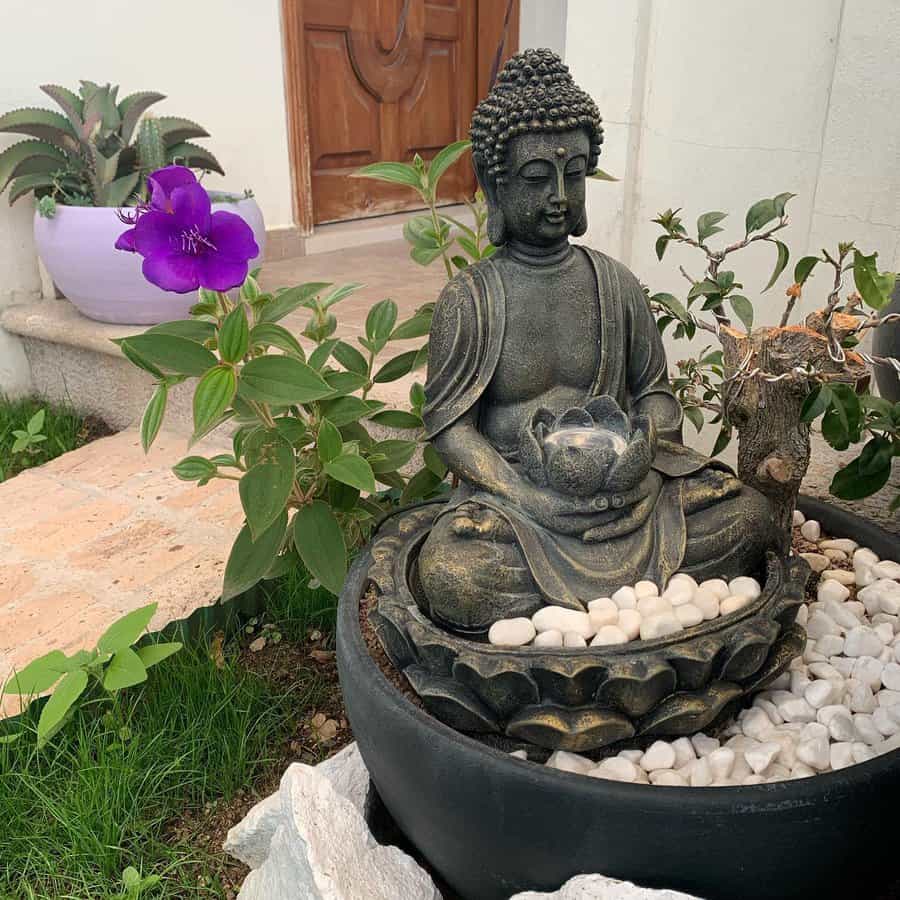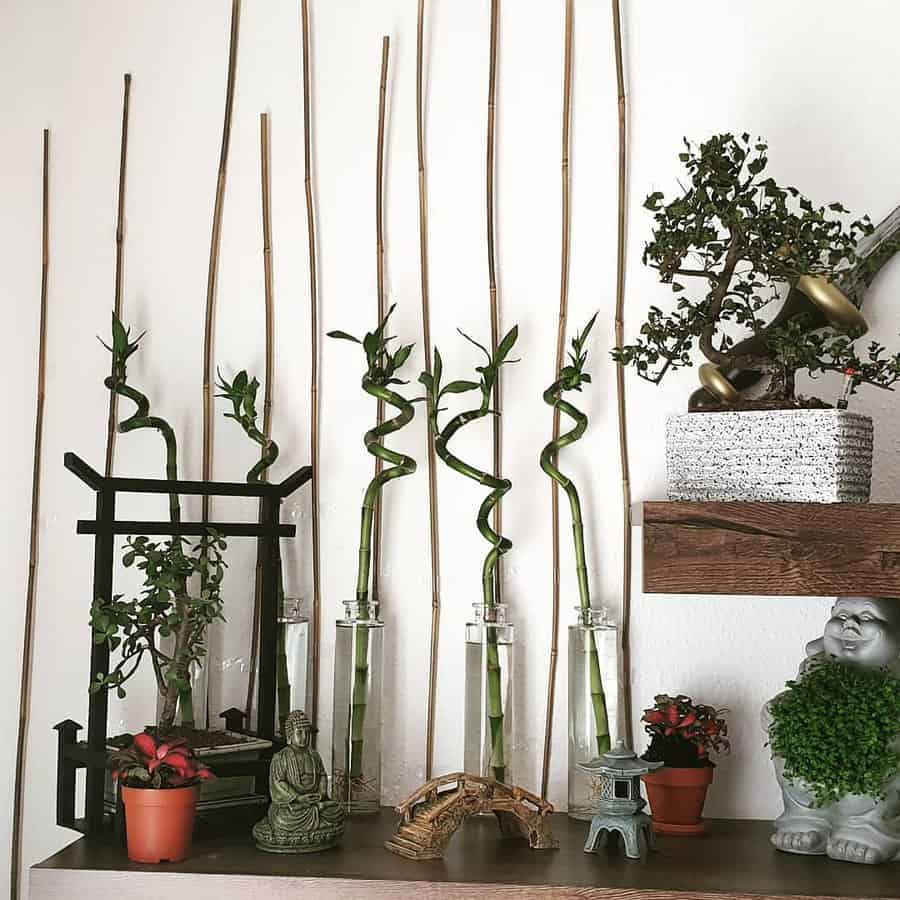Last Updated on: 9th May 2024, 07:48 am
Main Elements of Zen Garden Design
Contents

Layout and Flow
Creating a serene ambiance starts with a thoughtful layout. Paths of raked gravel or stepping stones enhance the flow, guiding you through the tranquil scenery. They invite slow, reflective walks.
Plants and Greenery
Balance is key. Choose plants that offer simplicity and harmony. Mosses, bamboo, and evergreens maintain a year-round lushness. Seasonal blooms, like cherry blossoms, add a fleeting beauty.
Water Features
Water elements symbolize renewal and calm. A small pond or waterfall can be the focal point, creating soundscapes that wash away the noise of the outside world.
Stones and Rocks
Stones anchor the garden’s design, representing islands or mountains in miniature landscapes. Their placement should feel both spontaneous and intentional, evoking natural ruggedness.
Main Elements of Zen Garden Design

Layout and Flow
Creating a serene ambiance starts with a thoughtful layout. Paths of raked gravel or stepping stones enhance the flow, guiding you through the tranquil scenery. They invite slow, reflective walks.
Plants and Greenery
Balance is key. Choose plants that offer simplicity and harmony. Mosses, bamboo, and evergreens maintain a year-round lushness. Seasonal blooms, like cherry blossoms, add a fleeting beauty.
Water Features
Water elements symbolize renewal and calm. A small pond or waterfall can be the focal point, creating soundscapes that wash away the noise of the outside world.
Stones and Rocks
Stones anchor the garden’s design, representing islands or mountains in miniature landscapes. Their placement should feel both spontaneous and intentional, evoking natural ruggedness.
Introduction to Zen Gardens

What is a Zen Garden?
A Zen garden, also known as a Japanese rock garden, invites stillness and contemplation. Its minimalistic approach uses rocks, gravel, and small patches of moss or foliage to symbolize the natural landscape.
History and Origin
Originating in Japan in the late Kamakura period, these gardens were initially designed at Zen Buddhist temples to aid in meditation. Over centuries, they have evolved but continue to embrace the essence of simplicity and tranquility.
Philosophy and Principles
- Simplicity (Kanso) – Stripping down to the essentials to foster a sense of calm.
- Nature (Shizen) – Mimicking natural landscapes in a stylized way.
- Subtlety (Yugen) – Suggesting more than what is visibly expressed.
- Stillness (Seijaku) – Cultivating an atmosphere of peace and self-reflection.
Benefits of Zen Gardens

Stress Reduction and Mental Health
Imagine a sanctuary where stress dissolves with each step you take. Zen gardens, with their minimalist beauty, are profound spaces for rejuvenation. The rhythmic raking of gravel and the presence of natural elements can significantly lower stress, enhancing mental clarity and emotional stability.
Enhancing Aesthetic Appeal
Each element of a Zen garden contributes to a visually harmonious landscape. The aesthetic simplicity not only soothes the mind but also transforms any backyard into a picturesque retreat, increasing the overall value and appeal of your home.
Connection to Nature
- Intimate Nature Experience – Even in urban settings, a Zen garden is a bridge to the natural world, fostering a deep, personal connection with nature.
- Sensory Engagement – The crunch of gravel, the softness of moss, and the solidity of rocks engage the senses, grounding you in the present moment.
Planning Your Zen Garden

Assessing Your Space
Begin by understanding the dimensions and natural features of your available space. Whether expansive or intimate, each area offers unique possibilities for creating a Zen retreat. Consider sunlight, existing vegetation, and topography to integrate your garden seamlessly with its surroundings.
Choosing a Theme
Themes can range from traditional Japanese aesthetics to more contemporary interpretations. Decide on a theme that resonates with your sense of tranquility—perhaps a minimalist composition with rocks and sand, or a lush setting with moss and ferns. This thematic approach guides your choices in plants and elements, ensuring a cohesive and meaningful design.
Materials and Tools Needed
- Rocks and Gravel: Essential for creating paths and patterns that encourage contemplation.
- Plants: Select species that thrive in your local climate and align with your chosen theme.
- Tools: Rakes for gravel, spades for planting, and perhaps a trowel for finer adjustments.
Design Ideas for Zen Garden Transformation
Decorative Zen Garden Ideas
Envision a sanctuary where water whispers and koi dance—a Zen garden that breathes life into stillness. Koi ponds ripple with vibrant energy, their inhabitants gliding like brushstrokes across a canvas of tranquility. Nearby, a fountain murmurs, its gentle cadence a lullaby for the soul.
Amidst this serene tableau, statues stand as silent guardians of calm. A Buddha, perhaps, or stones poised in delicate equilibrium, beckoning reflection and serenity. The art of cloud trimmings transforms foliage into soft, floating silhouettes, echoing the sky’s fleeting beauty.
Seasonal flowers punctuate the landscape with color, their ephemeral blooms a testament to nature’s cycle of life and rebirth. Each element, purposefully placed, weaves a narrative of harmony for the senses.
Buddha Zen Garden Ideas
Step into a realm of serenity with a Buddha Zen garden, a sanctuary where the essence of nature coalesces with spiritual calm. A Buddha statue, poised in eternal meditation, anchors your space, radiating tranquility and beckoning introspection. Nestle it amidst smooth river rocks—emblems of resilience—arranged to channel the flow of chi, the life force.
Introduce a verdant whisper with moss or subtle groundcovers, preserving the garden’s minimalist charm. Bamboo whispers in the wind, its dance a visual lullaby, enhancing the garden’s restful aura. Balance reigns supreme; each element’s placement is a deliberate act, cultivating harmony and fostering a haven for the soul.
Seeking a muse? Consider these thoughtfully selected ideas:
With each natural element and the enlightened one’s likeness, you sculpt more than a garden—you create a refuge for meditation, a canvas for reflection. Let your design choices be guided by mindfulness and purpose, the cornerstones of Zen, and behold as your garden transforms into a sanctuary for rejuvenation and spirit.
Fountain Zen Garden Ideas
Imagine a corner of serenity where water’s gentle murmur dances with the stillness of a Zen garden. Select a fountain that whispers tranquility, its soft babble a soothing undertone to your sanctuary. Choose a fountain that not only fits the spatial harmony but also resonates with a calming presence.
Smooth river rocks should cradle your water feature, enhancing its organic charm. Introduce low-maintenance greenery such as moss or ferns, their lush simplicity a visual whisper. Balance and harmony are the keystones of your Zen garden; every stone, water ripple, and green leaf is a note in a visual symphony of peace.
For a crescendo of calm, weave in bamboo or ornamental grasses. These elements stand as silent sentinels, enhancing the garden’s meditative quality. Here, you create not just a space, but an experience—a personal haven that invites stillness in the midst of life’s relentless pace.

Indoor Zen Garden Ideas
Envision a corner of your home transformed into a tranquil haven, a place where stillness and growth coexist. Crafting an indoor Zen garden is a journey towards serenity, a delicate balance of elements that invites calm into your bustling life.
Begin with a shallow tray, the canvas for your miniature landscape. Choose a Container that speaks to simplicity and elegance. Spread fine sand or gravel, and with a delicate touch, rake it into patterns that mimic the gentle flow of water. This act alone can become a meditative practice, centering your thoughts as you draw each line.
Strategically placed rocks serve as focal points within this sandy sea, their weight and texture a stark contrast to the smoothness around them. Select Rocks that resonate with you, each one a representation of strength and endurance.
Introduce life into your Zen garden with carefully chosen plants. Add Greenery like bonsai or succulents, their resilience and beauty a testament to nature’s adaptability. Opt for species that thrive with minimal water, ensuring your garden is not only a visual delight but also effortless to maintain.
Consider the ambiance of your space. Enhance Tranquility with elements that engage the senses – a candle’s flickering flame or the soft murmur of a fountain. These touches of light and sound are the final notes in your symphony of calm.
Remember, in the art of Zen, less is more. Each choice is deliberate, each detail purposeful. Your indoor Zen garden is not merely a decorative feature but a personal sanctuary, a space where the principles of Zen bloom amidst the confines of your home.

Table Zen Garden Ideas
Imagine a sanctuary on your table: a miniature Zen garden, a space where calm reigns and simplicity soothes the soul. Begin with a shallow dish, your canvas, and fill it with fine sand to mimic a vast, tranquil sea. Miniature rocks, carefully selected for their texture and form, become towering mountains in this serene landscape.
Introduce crystals to one corner, their unexpected sparkle catching the light, inviting contemplation of the mind’s hidden depths. Each rake through the sand, each stone’s placement, is a meditative act, centering the mind, calming the spirit. These table Zen gardens are more than decor; they are transformative, a portable retreat for peace at any moment.
Let these tiny sanctuaries be a reminder: breathe deeply, embrace stillness, even amidst life’s chaos. Cultivate your own peace, whether at home or in the office, with these potent symbols of tranquility.
Embracing Tranquility: Japanese Zen Garden Ideas
Step into serenity. A Japanese Zen garden captures the essence of calm, crafting a landscape that breathes mindfulness into every corner. Imagine a space where evergreens whisper tales of resilience, their lush foliage a testament to unyielding vitality. These stoic sentinels stand guard, anchoring the garden’s soul.
Rocks rise from raked gravel seas, sculptural islands that invite quiet contemplation. Their strategic placement is an art form, weaving balance and harmony into the garden tapestry. A pond, meanwhile, mirrors the sky, its surface a canvas for nature’s reflections. The soft murmur of water weaves through the air, an invitation to pause, to reflect.
Designing such a space is a deliberate act, a careful orchestration of elements to compose a symphony of stillness. A Zen garden is not merely seen—it is felt. It is an odyssey into tranquility.
- Evergreens Symbolize life’s continuity, offering green splendor all year round.
- Rocks Ground the space, creating focal points for meditation and reflection.
- Ponds Bring movement and depth, their waters reflecting the changing skies above.
In Closing
Embrace the serenity of Zen garden design. By integrating elements like raked gravel paths and tranquil water features, you can transform your backyard into a peaceful retreat. These designs not only enhance the aesthetic appeal of your space but also promote a deep, personal connection with nature, offering a sanctuary from the bustling world outside. Incorporate stones, plants, and water elements to create a harmonious and reflective landscape. Consider this your invitation to step into a world of tranquility, where every element is a step towards peace and mindfulness.





